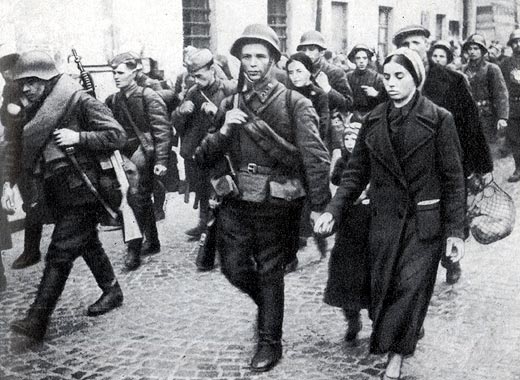Civilians Evacuate Leningrad, 22 January 1942

Soviet soldiers escort family towards evacuation Leningrad, 1942
The Siege of Leningrad, November 1941-January 1944
The city of Leningrad was situated on a narrow strip of land between the Gulf of Finland and Lake Ladoga. By mid-November 1941, German Army Group North had completed the encirclement of city, cutting off Leningrad and its three million inhabitants from the rest of the Soviet Union. Hitler had decided to bypass and starve Leningrad, committing the bulk of his forces on the push towards Moscow. The city had only one month’s worth of food remaining, and without being supplied by the outside world the daily ration was nine ounces of bread for workers and four ounces for their dependents. Bread in Leningrad at this point in time consisted of 25% sawdust. Although conditions continued to deteriorate rapidly in the besieged city, every effort was made to continue life with some degree of normalcy. During the 900 day siege, the public libraries, movie houses, schools and factories remained in operation, even though it is estimated that a German artillery shell or bomb struck Leningrad every three minutes.
The winter of 1941-42 was one of the coldest in memory. Public utilities were in shambles, so the citizens of Leningrad broke up their furniture to burn for heat. Starvation also began to take its toll; citizens began eating glue, and wallpaper was removed from buildings in an effort to extract the adhesive paste for consumption. Leather belts and shoes were boiled in an attempt to make them edible. There were even reports of cannibalism. It was common for citizens, in their weakened condition, to stop for a rest on their way to jobs in factories and freeze to death. Leningrad’s streets were littered with corpses that lay where they fell. But with the arrival of winter came one blessing: the freezing of Lake Ladoga. The city’s leadership worked to establish a ribbon-thin supply route over the frozen lake, and on 22 December 1941 the city began to receive enough provisions to increase the daily bread ration by four ounces. In spite of the increase, 200,000 Leningraders died of cold and hunger in the first two months of 1942.
Beginning today 70 years ago, hundreds of civilians began evacuating Leningrad by way of the supply line over Lake Ladoga, which became known both as the Road of Life as one could flee the besieged city on this route, as well as the Road of Death due to the extreme danger and high death rate of those using the dangerous road.
The defenders of Leningrad, however, remained undaunted. Kirovsky tractor factory began producing tanks for the war effort. These brand new T-34 tanks traveled only of one mile from the assembly line to the front lines. In the spring, cabbage was planted, food and fuel began entering the city by boat, and the city’s defenders were bolstered by fresh troops. Preparations were also made to have adequate food and fuel for the coming winter so as to not repeat the horrors of the previous one.
In January 1944, the Soviet army finally forced the retreat of the German forces surrounding Leningrad. The citizens of the city held out for an extraordinary 900 days, but many did not live to see the victory. It is conservatively estimated that one million Leningraders lost their lives during the siege, or one third of the city’s population.
This post by Curator Larry Decuers
- Posted :
- Post Category :
- Tags :
- Follow responses to this entry through the RSS 2.0 feed. You can skip to the end and leave a response. Pinging is currently not allowed.




Leave a Reply